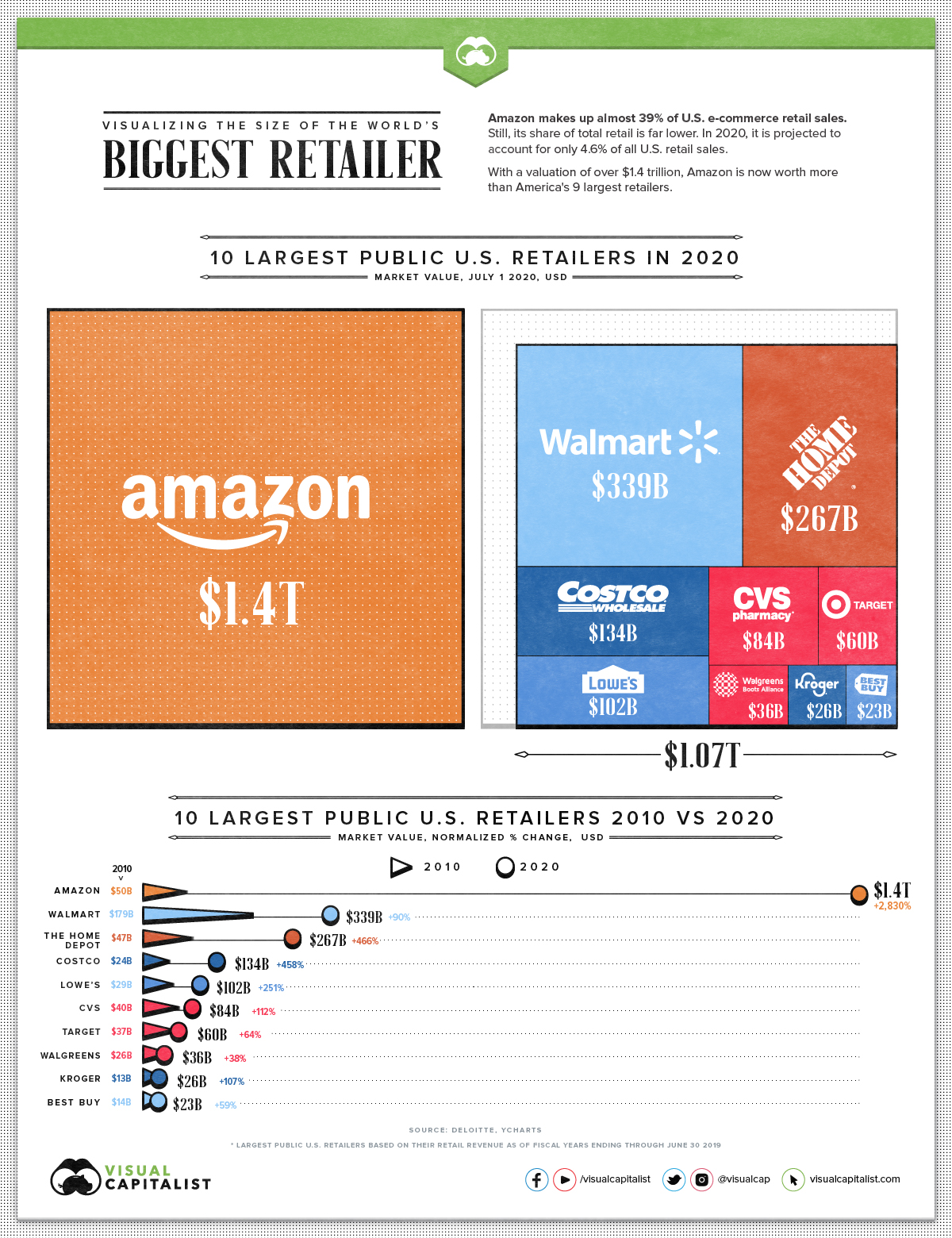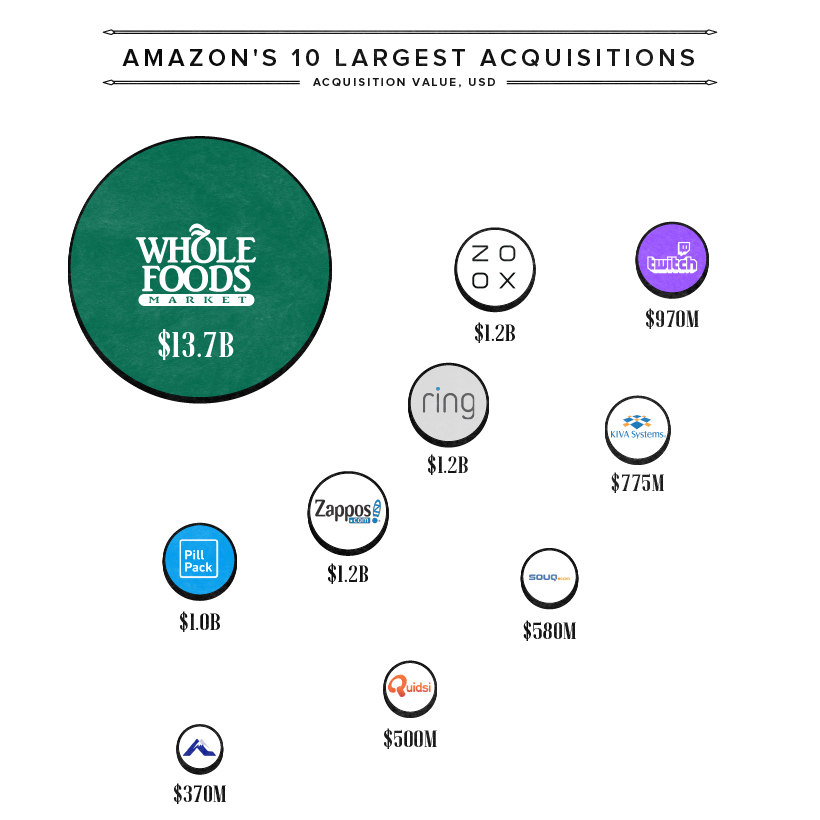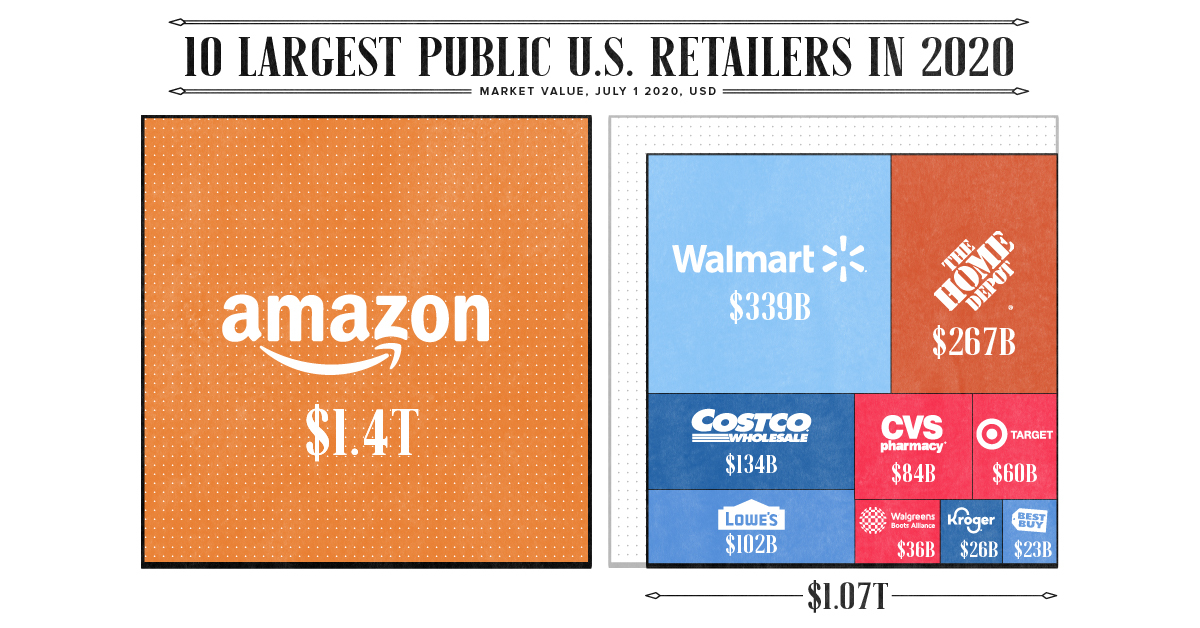Technology
Visualizing the Size of Amazon, the World’s Most Valuable Retailer

Visualizing the Size of the World’s Most Valuable Retailer
As brick-and-mortar chains teeter in the face of the pandemic, Amazon continues to gain ground.
The retail juggernaut is valued at no less than $1.4 trillion—roughly four times what it was in late 2016 when its market cap hovered around $350 billion. Last year, the Jeff Bezos-led company shipped 2 billion packages around the world.
Today’s infographic shows how Amazon’s market cap alone is bigger than the nine biggest U.S. retailers put together, highlighting the palpable presence of the once modest online bookstore.
The New Normal
COVID-19’s sudden shift has rendered many retail outfits obsolete.
Neiman Marcus, JCPenney, and J.Crew have all filed for bankruptcy as consumer spending has migrated online. This, coupled with heavy debt loads across many retail chains, is only compounding the demise of brick-and-mortar. In fact, one estimate projects that at least 25,000 U.S. stores will fold over the next year.
Still, as safety and supply chain challenges mount—with COVID-19 related costs in the billions—Amazon remains at the top. It surpasses its next closest competitor, Walmart, by $1 trillion in market valuation.
How does Amazon compare to the largest retailers in the U.S.?
| 10 Largest Public US Retailers* | Market Value July 1, 2020 | Market Value July 1, 2010 | Normalized % Change 2010-2020 | Retail Revenue |
|---|---|---|---|---|
| Walmart | $339B | $179B | 90% | $514B |
| Costco | $134B | $24B | 458% | $142B |
| Amazon | $1,400B | $50B | 2,830% | $140B |
| The Kroger Co. | $26B | $13B | 107% | $118Be |
| Walgreens Boots Alliance | $36B | $26B | 38% | $111B |
| The Home Depot | $267B | $47B | 466% | $108B |
| CVS | $84B | $40B | 112% | $84B |
| Target | $60B | $37B | 64% | $74B |
| Lowe's | $102B | $29B | 251% | $71B |
| Best Buy | $23B | $14B | 59% | $43B |
| Combined value of retailers (without Amazon) | $1,071B |
Source: Deloitte, YCharts
*Largest public US retailers based on their retail revenue as of fiscal years ending through June 30, 2019, e=estimated
With nearly a 39% share of U.S. e-commerce retail sales, Amazon’s market cap has grown 2,830% over the last decade. Its business model, which aggressively pursues market dominance instead of focusing on short-term profits, is one factor behinds the rise.
By the same token, one recent estimate by The Economist pegged Amazon’s retail operating margins at -1% last year. Another analyst has suggested that the company purposefully sells retail goods at a loss.
How Amazon makes up for this operating shortfall is through its cash-generating cloud service, Amazon Web Services (AWS), and through a collection of diversified enterprise-focused services. AWS, with estimated operating margins of 26%, brought in $9.2 billion in profits in 2019—more than half of Amazon’s total.
Amazon’s Basket of Eggs
Unlike many of its retail competitors, Amazon has rapidly diversified its acquisitions since it originated in 1994.
Take the $1.2 billion acquisition of Zoox. Amazon plans to operate self-driving taxi fleets, all of which are designed without steering wheels. It is the company’s third largest since the $13.7 billion acquisition of organic grocer Whole Foods, followed by Zappos.

Accounting for the lion’s share of Amazon-owned physical stores, Whole Foods has 508 stores across the U.S., UK, and Canada. While Amazon doesn’t outline revenues across its physical retail segments—which include Amazon Books stores, Amazon Go stores, and others—physical store sales tipped over $17 billion in 2019.
Meanwhile, Amazon also owns gaming streaming platform Twitch, which it acquired for $970 million in 2017. Currently, Twitch makes up 73% of the streaming market and brought in an estimated $300 million in ad revenues in 2019.
Carrying On
Despite the flood of online orders due to quarantines and social distancing requirements, Amazon’s bottom line has suffered. In the second quarter of 2020 alone, it is expected to rack up $4 billion in pandemic-related costs.
Yet, at the same time, its customer-obsessed business model appears to thrive under current market conditions. As of July 1, its stock price has spiked over 51% year-to-date. On an annualized basis, that’s roughly 100% in returns.
As margins get squeezed and expenses grow, is Amazon’s growth sustainable in the long-term? Or, are the company’s strategic acquisitions and revenue streams providing the catalysts (and cash) for only more short-term success?
Technology
Visualizing AI Patents by Country
See which countries have been granted the most AI patents each year, from 2012 to 2022.

Visualizing AI Patents by Country
This was originally posted on our Voronoi app. Download the app for free on iOS or Android and discover incredible data-driven charts from a variety of trusted sources.
This infographic shows the number of AI-related patents granted each year from 2010 to 2022 (latest data available). These figures come from the Center for Security and Emerging Technology (CSET), accessed via Stanford University’s 2024 AI Index Report.
From this data, we can see that China first overtook the U.S. in 2013. Since then, the country has seen enormous growth in the number of AI patents granted each year.
| Year | China | EU and UK | U.S. | RoW | Global Total |
|---|---|---|---|---|---|
| 2010 | 307 | 137 | 984 | 571 | 1,999 |
| 2011 | 516 | 129 | 980 | 581 | 2,206 |
| 2012 | 926 | 112 | 950 | 660 | 2,648 |
| 2013 | 1,035 | 91 | 970 | 627 | 2,723 |
| 2014 | 1,278 | 97 | 1,078 | 667 | 3,120 |
| 2015 | 1,721 | 110 | 1,135 | 539 | 3,505 |
| 2016 | 1,621 | 128 | 1,298 | 714 | 3,761 |
| 2017 | 2,428 | 144 | 1,489 | 1,075 | 5,136 |
| 2018 | 4,741 | 155 | 1,674 | 1,574 | 8,144 |
| 2019 | 9,530 | 322 | 3,211 | 2,720 | 15,783 |
| 2020 | 13,071 | 406 | 5,441 | 4,455 | 23,373 |
| 2021 | 21,907 | 623 | 8,219 | 7,519 | 38,268 |
| 2022 | 35,315 | 1,173 | 12,077 | 13,699 | 62,264 |
In 2022, China was granted more patents than every other country combined.
While this suggests that the country is very active in researching the field of artificial intelligence, it doesn’t necessarily mean that China is the farthest in terms of capability.
Key Facts About AI Patents
According to CSET, AI patents relate to mathematical relationships and algorithms, which are considered abstract ideas under patent law. They can also have different meaning, depending on where they are filed.
In the U.S., AI patenting is concentrated amongst large companies including IBM, Microsoft, and Google. On the other hand, AI patenting in China is more distributed across government organizations, universities, and tech firms (e.g. Tencent).
In terms of focus area, China’s patents are typically related to computer vision, a field of AI that enables computers and systems to interpret visual data and inputs. Meanwhile America’s efforts are more evenly distributed across research fields.
Learn More About AI From Visual Capitalist
If you want to see more data visualizations on artificial intelligence, check out this graphic that shows which job departments will be impacted by AI the most.
-

 Markets1 week ago
Markets1 week agoU.S. Debt Interest Payments Reach $1 Trillion
-

 Markets2 weeks ago
Markets2 weeks agoRanked: The Most Valuable Housing Markets in America
-

 Money2 weeks ago
Money2 weeks agoWhich States Have the Highest Minimum Wage in America?
-

 AI2 weeks ago
AI2 weeks agoRanked: Semiconductor Companies by Industry Revenue Share
-

 Markets2 weeks ago
Markets2 weeks agoRanked: The World’s Top Flight Routes, by Revenue
-

 Countries2 weeks ago
Countries2 weeks agoPopulation Projections: The World’s 6 Largest Countries in 2075
-

 Markets2 weeks ago
Markets2 weeks agoThe Top 10 States by Real GDP Growth in 2023
-

 Money2 weeks ago
Money2 weeks agoThe Smallest Gender Wage Gaps in OECD Countries

 Can I share this graphic?
Can I share this graphic? When do I need a license?
When do I need a license? Interested in this piece?
Interested in this piece?













